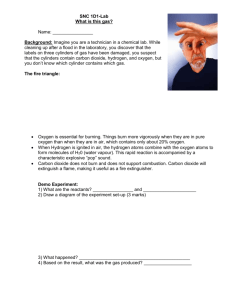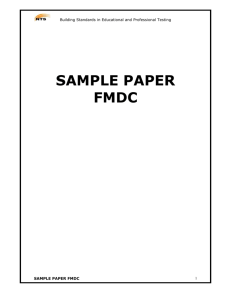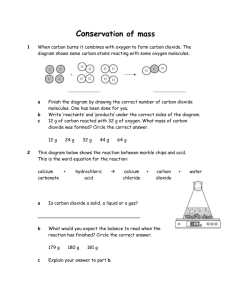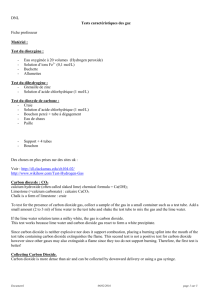docx - STAO
advertisement
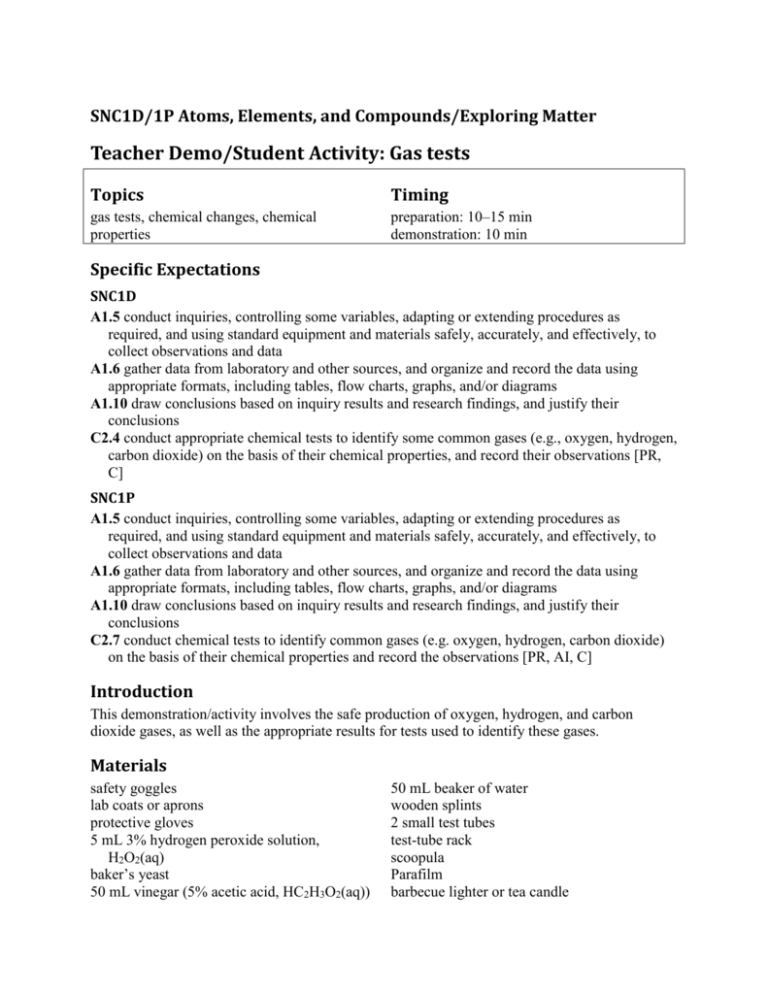
SNC1D/1P Atoms, Elements, and Compounds/Exploring Matter Teacher Demo/Student Activity: Gas tests Topics Timing gas tests, chemical changes, chemical properties preparation: 10–15 min demonstration: 10 min Specific Expectations SNC1D A1.5 conduct inquiries, controlling some variables, adapting or extending procedures as required, and using standard equipment and materials safely, accurately, and effectively, to collect observations and data A1.6 gather data from laboratory and other sources, and organize and record the data using appropriate formats, including tables, flow charts, graphs, and/or diagrams A1.10 draw conclusions based on inquiry results and research findings, and justify their conclusions C2.4 conduct appropriate chemical tests to identify some common gases (e.g., oxygen, hydrogen, carbon dioxide) on the basis of their chemical properties, and record their observations [PR, C] SNC1P A1.5 conduct inquiries, controlling some variables, adapting or extending procedures as required, and using standard equipment and materials safely, accurately, and effectively, to collect observations and data A1.6 gather data from laboratory and other sources, and organize and record the data using appropriate formats, including tables, flow charts, graphs, and/or diagrams A1.10 draw conclusions based on inquiry results and research findings, and justify their conclusions C2.7 conduct chemical tests to identify common gases (e.g. oxygen, hydrogen, carbon dioxide) on the basis of their chemical properties and record the observations [PR, AI, C] Introduction This demonstration/activity involves the safe production of oxygen, hydrogen, and carbon dioxide gases, as well as the appropriate results for tests used to identify these gases. Materials safety goggles lab coats or aprons protective gloves 5 mL 3% hydrogen peroxide solution, H2O2(aq) baker’s yeast 50 mL vinegar (5% acetic acid, HC2H3O2(aq)) 50 mL beaker of water wooden splints 2 small test tubes test-tube rack scoopula Parafilm barbecue lighter or tea candle 5 g baking soda (sodium hydrogen carbonate, NaHCO3(s)) limewater (saturated calcium hydroxide solution, Ca(OH)2(aq)) tap water calcium metal, Ca(s) 100 mL beaker square of cardboard 250 mL beaker 1 medium-sized test tube tongs or forceps NOTE: The quantities of chemicals and materials listed above are enough for the gas test activity/demonstration to be completed once. For an activity, the materials will need to be multiplied by the number of groups of students in the class. STAO recommends that the preparation of hydrogen using calcium and water is demonstrated by the teacher and not undertaken by students. Safety Considerations Provide MSDS sheets for all chemicals used. Wear chemical safety goggles during this demonstration to protect the eyes from any splashes. In addition, wear a lab coat or apron. Calcium metal reacts vigorously with water, so use only small quantities. Wear protective gloves when handling this metal. Students should not handle calcium. Bring into the classroom only the minimum quantity of reagent needed to complete the demonstration. All chemical stock containers should remain in the chemical storage area. Ensure that the work space is free of clutter during the demonstration since there will be an open flame present. Remind students of emergency procedures related to fires (extinguisher use, fire exit, etc.). Ensure that the splints are extinguished before being thrown away. The reaction of calcium with water produces the strong base calcium hydroxide; this basic solution should be handled with care during disposal. Hazardous Materials Identification System Rating (0-minimal 1-slight 2-moderate 3-serious 4-severe) sodium bicarbonate, calcium metal, Ca(s) NaHCO3(s) Health Fire Hazard Reactivity 1 0 0 acetic acid solution, CH3CO2H(aq) (5%) Health Fire Hazard Reactivity 2 0 0 Health Fire Hazard Reactivity 3 2 2 limewater/calcium hydroxide solution, Ca(OH)2(aq) Health 1 Fire Hazard 0 Reactivity 0 hydrogen peroxide solution, H2O2(aq) (3%) Health 2 Fire Hazard 0 Reactivity 0 Procedure Ensure that all participants are wearing appropriate PPE: chemical safety goggles and lab coat or apron. 1. Introduce the students to the fire triangle, explaining the need for fuel, heat, and oxygen for a fire to ignite and continue to burn. Also emphasize that the absence of any one of these factors will prevent combustion from occurring. 2. Have the students discuss how they might light a fire and methods to extinguish it. Part One – Oxygen 3. Predict/Explain Show the students a burning splint and ask them to identify which parts of the fire triangle are present. 4. Ask the students to predict what might happen if the fire were extinguished and more oxygen were then added to the glowing embers. 5. Observe Pour 3–5 mL 3% hydrogen peroxide solution into a small test tube. Place the test tube in a test-tube rack. 6. Add a scoop of baker’s yeast approximately the size of a pea to the test tube. 7. Cover the mouth of the test tube with a square of Parafilm and allow the pressure to accumulate for a couple of seconds. 8. Use the barbecue lighter or lit candle to ignite a wooden splint, and then blow it out so that the ember glows red. 9. Quickly remove the Parafilm and immediately insert the glowing splint into the mouth of the test tube. The splint should reignite. 10. Immerse the burning splint in a small beaker of water to completely extinguish the flame. 11. Explain Ask students to use the fire triangle to explain their prediction, i.e., what did the reaction provide that caused the splint to reignite? Part Two – Carbon Dioxide 12. Predict/Explain Ask the students to predict what will happen if a burning splint is placed in a sample of carbon dioxide. Have them make a connection to the fire triangle. 13. Observe Pour the vinegar into the 100 mL beaker and add a generous scoop of baking soda. The reaction will begin immediately. 14. Since carbon dioxide is denser than air, the mouth of the beaker does not need to be sealed. However, place a piece of cardboard over the mouth of the beaker to ensure that the air currents in the room do not prevent the gas from accumulating above the vinegar solution. 15. Ignite a wooden splint using a barbecue lighter or tea candle. The flame will be extinguished when the splint is inserted into the beaker above the bubbling solution. Keep a small beaker of water at hand to completely extinguish the splint. 16. 17. Explain Invite the students to use the fire triangle to explain their predictions. (They may need a hint: as the quantity of one substance increases in the beaker, the quantity of another substance may decrease.) Carbon Dioxide Test: This is done by pouring carbon dioxide gas from the beaker into a beaker of lime water (a saturated solution of calcium hydroxide). Lime water becomes cloudy in the presence of carbon dioxide. This is the definitive test for this gas. Part Three – Hydrogen (Teacher Demonstration only) 18. Predict/Explain Have students predict what will happen when the splint is placed in the hydrogen gas. 19. Observe Pour 50 mL of water into the 250 mL beaker. 20. Fill a test tube with water. Place a small piece of paper over the mouth of the test tube. Invert the tube and place it into the beaker. Remove the paper with a pair of tongs or forceps. 21. Use tongs to place a piece of calcium about the half the size of a pea into the beaker. 22. Hold the mouth of the inverted test tube over the calcium to capture the bubbles until approximately 1/3 of the water has been displaced. 23. Lift the tube out of the water, keeping the tube inverted. As water drains from the test tube, air will enter and mix with the hydrogen gas. Since hydrogen is less dense than air, it will remain at the closed end of the test tube, provided the test tube remains inverted. 24. Bring a burning splint to the mouth of the test tube. You should hear a loud popping noise. 25. Explain Ask students if their predictions were correct and, if not, do they have an explanation for what they observed. Disposal The mixture left over from the oxygen gas production (water and yeast) can be poured down the sink. The mixture resulting from the reaction of calcium and water should be neutralized with a small volume of vinegar and flushed down the sink with lots of water. The calcium can be allowed to react completely or it can be salvaged and disposed of with other reactive metals. The products from the carbon dioxide gas production can also be safely rinsed down the sink. Follow disposal procedures that are consistent with school board protocol and appropriate for your municipality. What happens? Oxygen The catalase enzyme in yeast catalyzes the decomposition of hydrogen peroxide in the solution, releasing oxygen gas. catalyst 2 H2O2(aq) → 2 H2O(l) + O2(g) The oxygen will re-ignite the glowing splint. Carbon Dioxide The reaction of sodium bicarbonate with acetic acid produces carbon dioxide and water, as well as a salt. NaHCO3(s) + HC2H3O2 (aq) → CO2(g) + H2O(l) + NaC2H3O2 (aq) The burning splint is extinguished in the presence of carbon dioxide gas. Hydrogen Calcium reacts with water to produce calcium hydroxide solution and gaseous hydrogen. Ca(s) + 2 H2O(l) → Ca(OH)2(aq) + H2(g) The pop of a burning splint is a positive test for hydrogen gas. How does it work? Oxygen The concentrated oxygen gas promotes re-ignition of the splint. Carbon Dioxide Carbon dioxide is denser than air so, as long as the air currents in the room are minimal, the carbon dioxide produced will accumulate above the vinegar solution. The abundant carbon dioxide deprives the flame of oxygen and extinguishes the flame. Hydrogen The hydrogen gas serves as fuel, and as long as it is mixed with enough oxygen it will combust completely and rapidly. The loud pop results from the pressure in the test tube rapidly changing. Water vapour, produced by the combustion of hydrogen, will condense on the inside of the mouth of the test tube, causing it to become slightly foggy. 2 H2(g) + O2(g) → 2 H2O(g) + energy If there is no oxygen mixed with the hydrogen, the hydrogen will burn only at the interface where it mixes with the oxygen. Teaching Suggestions/Hints 1. 2. 3. 4. 4. 5. 6. After a bottle of hydrogen peroxide is opened it has a short shelf life. Keep the stock bottle in the refrigerator and opened it no more than a few days before performing the experiment. If using concentrated hydrogen peroxide to prepare the dilute solution, take extreme care to avoid severe chemical burns. You could use manganese dioxide, MnO2(s), or potassium iodide, KI(s) to catalyze the reaction if yeast is not available. Dispose of waste manganese dioxide in accordance with school board protocol and as appropriate for your municipality. It should not be flushed down the sink. Lime water becoming cloudy is the definitive test for carbon dioxide. Ca(OH)2(aq) + CO2(g) → CaCO3(s) + H2O(l) Extinguishing a flame is not a characteristic property of carbon dioxide since many other gases also extinguish flames. Ask students to develop a chart that summarizes their observations and also describes the definitive tests for the gases investigated in this demo. Discuss the Hindenburg tragedy and connect it to the hydrogen gas test. Show the test for water vapour using cobalt chloride paper. 7. To make lime water (saturated solution of calcium hydroxide): a. Wear chemical safety goggles, a lab coat or apron, and protective gloves when handling calcium hydroxide. b. Add 1 tsp of calcium hydroxide, Ca(OH)2(s), to a 1 L bottle of water. c. Seal the bottle and swirl vigorously for 1–2 min. d. Allow the solution to settle for 24 h, and then filter the clear solution at the top through coffee filter (Fig.1). e. Prepare a fresh solution for each demo since carbon dioxide in the air will react with the solution, causing a precipitate to form and the solution to become unreactive. ...::: Fig.1 Make fresh limewater solution each time. ::... Next Steps Follow up this activity with “The Candle Family” in which students use their understanding of ...::: combustion to predict the order in which candles of different sizes in a sealed container are extinguished. ::... Additional resources 1. 2. STAO Fire Safety Resource - Video #2 “Testing Gases: H2, O2, and CO2” For the lime-water test http://www.youtube.com/watch?v=O5dhYLi4Y1c&feature=related
